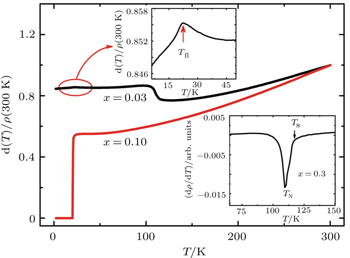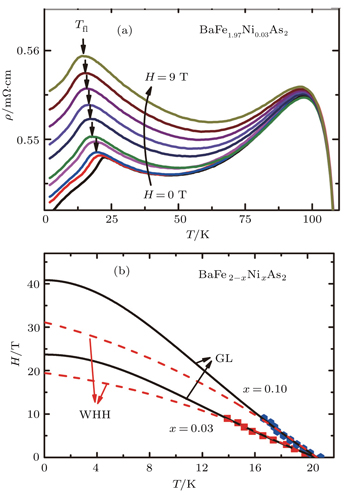† Corresponding author. E-mail:
‡ Corresponding author. E-mail:
Project supported by the National Basic Research Program of China (Grant Nos. 2012CB821400, 2012CB921302, and 2015CB921303) and the National Natural Science Foundation of China (Grant Nos. 11274237, 91121004, 51228201, 11004238, and 11374011).
We present magnetotransport studies on a series of BaFe2−xNixAs2 (0.03 ≤ x ≤ 0.10) single crystals. In the underdoped (x = 0.03) non-superconducting sample, the temperature-dependent resistivity exhibits a peak at 22 K, which is associated with the onset of filamentary superconductivity (FLSC). FLSC is suppressed by an external magnetic field in a manner similar to the suppression of bulk superconductivity in an optimally-doped (x = 0.10) compound, suggesting the same possible origin as the bulk superconductivity. Our magnetoresistivity measurements reveal that FLSC persists up to the optimal doping and disappears in the overdoped regime where the long-range antiferromagnetic order is completely suppressed, pointing to a close relation between FLSC and the magnetic order.
The discovery of unconventional superconductivity in iron pnictides[1] has aroused a tremendous amount of research into this class of materials in an effort to understand the mechanism of high-Tc superconductivity, as well as to explore materials with higher Tc. The parent compounds of these iron-based superconductors (FeSCs) are poor Pauli-paramagnetic metals in their high-temperature phase, and undergo structural and antiferromagnetic (AFM) phase transitions upon cooling down to low temperature.[2–4] Superconductivity emerges with the suppression of the AFM order via chemical substitution[5–7] or the application of pressure.[8–11] Since optimal superconductivity is accompanied by the disappearance of the AFM phase, AFM spin fluctuations have been proposed to mediate the electronic pairing in FeSCs.[12] On the other hand, previous spectroscopic studies have also revealed strong competition between the AFM order and superconductivity in the Ba122 system.[13,14] Therefore, the relation between magnetism and superconductivity is still a matter of debate in FeSCs.
In this article, we report our results of magnetotransport measurements on BaFe2−xNixAs2 single crystals with different Ni concentration. An abrupt drop of the resistivity at ∼22 K in underdoped x = 0.03 has been observed in the temperature-dependent resistivity as evidence for the onset of filamentary superconductivity (FLSC). An external magnetic field suppresses FLSC in a manner similar to the suppression of the bulk Tc in an optimally-doped (x = 0.10) sample, suggesting a possible connection between FLSC and bulk SC. In addition, FLSC is robust and exhibits little doping dependence in the underdoped regime, but vanishes abruptly in the overdoped region where long-range AFM order is absent. These results indicate that the emergence of FLSC is intimately related to the magnetic order in FeSCs.
High-quality single crystals of BaFe2−xNixAs2 with a series of Ni doping were grown using a self-flux method.[15] Typical dimensions of single crystals for measurements are approximately 1 mm × 0.25 mm × 0.05 mm. In-plane resistivity was measured as a function of temperature in a physical property measurements system (PPMS-9, Quantum Design) using a standard four-electrode method. The current used for measurements is parallel to the basel plane and I = 1 mA.
Figure
The top panel of Fig.
In addition, the upper critical fields in these two samples are also fitted by the Ginzburg–Landau (GL) model and the Werthamer–Helfand–Hohenberg (WHH) model. As shown in the bottom panel of Fig.


While we observed an obvious drop of resistivity in ρ(T) curves for the x = 0.03 sample, some studies showed that the step in the low-temperature resistivity is not always observed in 122-type parent compound in iron pnictide superconductors. For example, Xiao et al. reported that this step was observed only for small and thin single crystals in undoped BaFe2As2.[17] Tanatar et al. studied different samples of parent compounds CaFe2As2 and BaFe2As2, and found that two samples showed the partial superconducting transition in three undoped CaFe2As2, and even only two samples showed the partial superconducting transition in five different BaFe2As2 samples.[24] For this reason, we performed magnetoresistivity measurements, which is believed to be more sensitive to the small decrease in resistivity due to filamentary superconductivity.
Figure
In Fig.
 | Fig. 4. Doping-x dependence of Ts, TN, Tc, and Tfl phase diagram. Tfl in parent compound BaFe2As2 is obtained from Ref. [17]. |
However, some recent experimental results revealed that SC and AFM order parameters are spatially modulated on a microscopic scale in iron pnictides.[24–26] For example, many studies showed the evidence for the existence of the structural domain like twin boundary and antiphase domain wall in the iron pictides.[24,26] Meanwhile, a recent SQUID microscopy study in underdoped Ba(Fe1−xCox)2As2 showed an enhanced superfluid density on twin boundaries[25] and 75As nuclear magnetic resonance (NMR) measurements in antiferromagnetic CaFe2As2 suggests the presence of FLSC nucleated at the AFM domain walls.[16] All these results indicate that AFM order is vital to the emergence of SC in iron pnictides.
In combination with our previous studies in CaFe2As2 and Ba(Fe1−xCox)2As2,[16,17] we find that FLSC exists in electron-doped 122-type iron-based superconductors and it has a close connection with AFM order. Besides, Chu et al. also revealed an obvious FLSC with a high Tc = 49 K in single crystalline CaFe2As2 via electron-doping by partial replacement of Ca by rare-earth.[27,28] Thus our results suggest that the FLSC may be a common feature in the AFM phase of iron pnictides due to strong coupling between AFM and superconductivity, further exploration is needed to verify it.
In conclusion, magnetotransport measurements have been carried out on a series of Ni doping BaFe2As2 single crystals. A similar suppression of FLSC Tfl and bulk SC Tc by external magnetic field is depicted in the H–T phase diagram. The doping-temperature phase diagram reveals the following results: (i) FLSC is less doping-dependent compared with bulk SC; (ii) FLSC coexists with AFM order and vanishes in the edge of optimal doping where long-range AFM order is absent. Based on our results, we conclude that FLSC is closely linked with magnetic order and the bulk SC in iron pnictides.
| 1 | |
| 2 | |
| 3 | |
| 4 | |
| 5 | |
| 6 | |
| 7 | |
| 8 | |
| 9 | |
| 10 | |
| 11 | |
| 12 | |
| 13 | |
| 14 | |
| 15 | |
| 16 | |
| 17 | |
| 18 | |
| 19 | |
| 20 | |
| 21 | |
| 22 | |
| 23 | |
| 24 | |
| 25 | |
| 26 | |
| 27 | |
| 28 |





